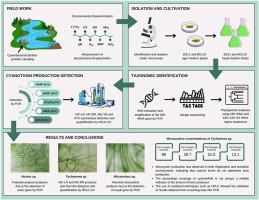First report of microcystin-producing benthic cyanobacteria in Mexican mountain rivers: polyphasic characterization and HPLC toxin detection
IF 2.4
4区 医学
Q2 PHARMACOLOGY & PHARMACY
引用次数: 0
Abstract
The detection and characterization of cyanotoxins produced by benthic cyanobacteria in rivers is an understudied topic compared to cyanotoxins produced by planktonic cyanobacteria. Particularly, detection methods for cyanotoxin-producing species in Latin America and Mexico continue to focus primarily on microscopy, with relatively scarce molecular detection. Herein, we present the first study in Mexican rivers that identifies a population of the genus Tychonema as a producer of two variants of microcystins, MC-LR and MC-RR, through a polyphasic approach that includes the quantification of toxins by HPLC-UV. Likewise, two populations of Nostoc and Microcoleus were identified and, based on the identification of the anaC and mcyE genes via PCR, may be producers of anatoxins and microcystins, respectively; however, this production could not be confirmed in the HPLC-UV analysis. Active microcystins production was observed in eutrophic environments, while potential production was recorded in populations in oligotrophic environments. Therefore, the presence of producing strains in both types of environment cannot be ruled out. We propose that toxin production could be a mechanism of competition against other microorganisms that make up benthic mats, rather than a direct response to eutrophication. We also found that the percent coverage of toxic cyanobacterial mats is not always a reliable indicator of the amount of toxin produced. Microcoleus sp. showed a higher percent coverage in the river but was not toxic, while Tychonema sp. Produced significant amounts of MC-LR and MC-RR under the same culture conditions despite less coverage in the river. We strongly recommend the implementation of multiple techniques and methods for identifying populations of toxin-producing benthic cyanobacteria (CyanoHAMs) in Mexican rivers in order to validate the results and develop a prevention plan against their associated risks.

墨西哥山区河流中产生微囊藻毒素的底栖蓝藻首次报道:多相表征和高效液相色谱毒素检测。
与浮游蓝藻产生的蓝藻毒素相比,对河流中底栖蓝藻产生的蓝藻毒素的检测和表征是一个尚未充分研究的课题。特别是,在拉丁美洲和墨西哥,对产生蓝藻毒素的物种的检测方法仍然主要集中在显微镜上,相对较少的分子检测。在此,我们首次在墨西哥河流中进行研究,通过多相方法(包括HPLC-UV定量毒素),确定了Tychonema属种群是两种微囊藻毒素(MC-LR和MC-RR)变体的生产者。同样,我们还鉴定出了Nostoc和Microcoleus两个群体,通过PCR鉴定出anaC和mcyE基因,它们可能分别产生anatoxin和microcystins;但该产物在HPLC-UV分析中无法得到证实。富营养化环境中观察到微囊藻毒素的活性产生,而贫营养化环境中记录到潜在的微囊藻毒素产生。因此,不能排除在这两种环境中都存在生产菌株。我们提出毒素的产生可能是一种与构成底栖垫的其他微生物竞争的机制,而不是对富营养化的直接反应。我们还发现,有毒蓝藻垫的百分比覆盖率并不总是毒素产生量的可靠指标。微藻(Microcoleus sp.)在河流中显示出较高的覆盖率,但没有毒性,而Tychonema sp.在相同的培养条件下产生了大量的MC-LR和MC-RR,尽管在河流中的覆盖率较低。我们强烈建议实施多种技术和方法来识别墨西哥河流中产生毒素的底栖蓝藻(CyanoHAMs)种群,以验证结果并制定预防计划,以防止其相关风险。
本文章由计算机程序翻译,如有差异,请以英文原文为准。
求助全文
约1分钟内获得全文
求助全文
来源期刊

Toxicon
医学-毒理学
CiteScore
4.80
自引率
10.70%
发文量
358
审稿时长
68 days
期刊介绍:
Toxicon has an open access mirror Toxicon: X, sharing the same aims and scope, editorial team, submission system and rigorous peer review. An introductory offer Toxicon: X - full waiver of the Open Access fee.
Toxicon''s "aims and scope" are to publish:
-articles containing the results of original research on problems related to toxins derived from animals, plants and microorganisms
-papers on novel findings related to the chemical, pharmacological, toxicological, and immunological properties of natural toxins
-molecular biological studies of toxins and other genes from poisonous and venomous organisms that advance understanding of the role or function of toxins
-clinical observations on poisoning and envenoming where a new therapeutic principle has been proposed or a decidedly superior clinical result has been obtained.
-material on the use of toxins as tools in studying biological processes and material on subjects related to venom and antivenom problems.
-articles on the translational application of toxins, for example as drugs and insecticides
-epidemiological studies on envenoming or poisoning, so long as they highlight a previously unrecognised medical problem or provide insight into the prevention or medical treatment of envenoming or poisoning. Retrospective surveys of hospital records, especially those lacking species identification, will not be considered for publication. Properly designed prospective community-based surveys are strongly encouraged.
-articles describing well-known activities of venoms, such as antibacterial, anticancer, and analgesic activities of arachnid venoms, without any attempt to define the mechanism of action or purify the active component, will not be considered for publication in Toxicon.
-review articles on problems related to toxinology.
To encourage the exchange of ideas, sections of the journal may be devoted to Short Communications, Letters to the Editor and activities of the affiliated societies.
 求助内容:
求助内容: 应助结果提醒方式:
应助结果提醒方式:


